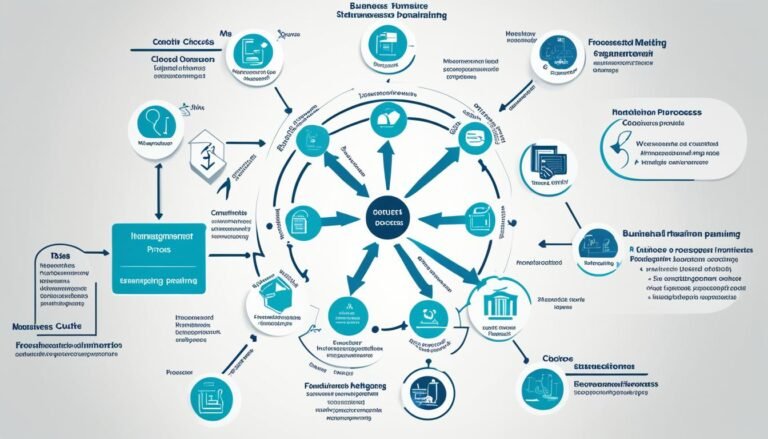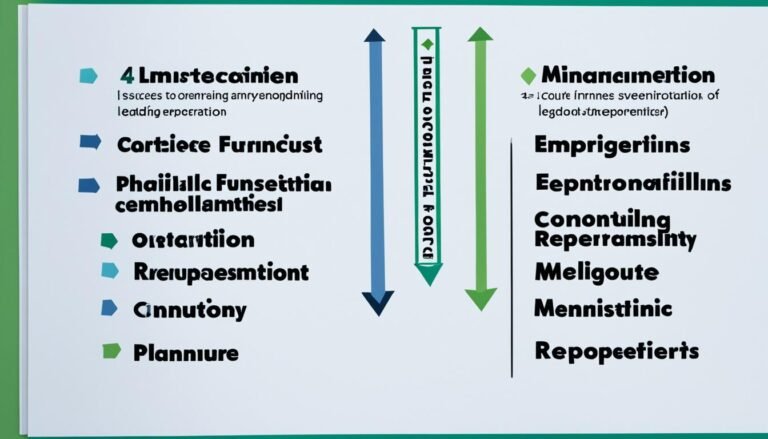What strategies help in managing large-scale organizational changes?
Were you aware that about 70% of large changes within organizations don’t fully succeed? Change is often tough, especially when it’s on a big scale. To make sure these efforts lead to the desired results, leaders must use powerful strategies. These strategies should smooth the way for change and help with planning the transformation.
This piece will look at critical strategies for handling big organizational shifts. We’ll go over the importance of good change management. We’ll also share tips on how to get past challenges and use the best methods. Our goal is to offer key advice. This advice should help guide you to success in your transformation efforts. Let’s start exploring these strategies that make a real impact on reaching your goals.
Key Takeaways:
- Approximately 70% of organizational change initiatives fail to meet their objectives.
- Effective change management strategies are essential for successful large-scale organizational changes.
- Leaders should prioritize organizational transformation planning and adopt optimal approaches to navigate change.
- Understanding the importance of change management and overcoming obstacles are crucial for success.
- Implementing best practices, such as effective communication and addressing resistance, is vital in managing change effectively.
The Importance of Change Management in Large-Scale Organizational Changes
Change management is vital in big organizational shifts. It helps leaders guide their teams smoothly through changes. Using the right strategies and practices makes a big difference.
Leading change means dealing with personal and group challenges. It’s about making sure everyone understands and feels supported. This encourages them to get involved and stay committed.
Good change management stops problems before they start. It tackles resistances, answers worries, and makes the shift easy. A structured approach boosts chances of success.
“Change is inevitable. Successful leaders get why change management is key. It helps their companies grow and stay competitive in today’s fast-changing world.”
To make change work, organizations need a culture that welcomes it. Employees should see change as a chance to do better. Including them in planning opens up new ideas and shows they matter.
The table below shows some top change management tips:
| Best Practices for Change Management |
|---|
| 1. Develop a clear vision and purpose for the change |
| 2. Communicate the change clearly and frequently |
| 3. Engage and involve employees at all levels |
| 4. Provide training and support to build necessary skills |
| 5. Monitor progress and adapt the change strategy as needed |
Following these tips helps leaders bring about real change. It keeps their organizations relevant and strong in the long run.
Key Elements of Successful Organizational Change Strategies
Creating successful organizational change takes careful planning and execution. Leaders need to use important elements in their change approach. This helps them deal with the complex shifting within the organization and establish lasting changes. Here are the vital elements for effective organizational change:
Clear Vision and Purpose
A clear vision and purpose guide the change effort. They show what the change is aiming for and align everyone’s work. It’s crucial for leaders to share this vision clearly. It ensures the whole team knows the change’s purpose and direction.
Comprehensive Change Plan
A solid change plan includes all the steps to make the change happen. It should talk about when things will happen, what resources are needed, and key goals. This plan helps cut down on confusion and gives everyone a clear path to follow in the change process.
Engaging Stakeholders
It’s key to get everyone on board for the change. Leaders need to involve important people and teams. This approach does more than just bring in support. It gathers different views, builds trust, and makes the team feel part of the change process. This pushes for better results.
Provision of Resources and Support
Having the right tools and support is essential for change success. This means having the right funds, technology, training, and expert help. Offering these resources lets everyone jump into the change with courage. It also helps them solve any problems that may come up.
Continuous Monitoring and Adaptation
Change is an ongoing thing. It needs to be watched and tweaked all the time. Leaders must keep track of how the change is going. They should find and fix any problems and keep things going smoothly. Regular checks and data inform smart decision-making during the change.
“Successful organizational change strategies involve having a clear vision, a comprehensive change plan, and engaging stakeholders. Leaders must also provide resources and support while continuously monitoring and adapting the change strategy.”
Effective leaders are ready for change, can adapt, and value feedback. Adding these elements into their change plans boosts their chance of success.
Overcoming Obstacles in Implementing Change
Bringing change to organizations can face hurdles. Examples include when workers don’t want the change or when messages aren’t clear. This can happen because someone is scared, doesn’t get it, or just doesn’t want to change. Leaders need to tackle these issues. This ensures that changing things goes smoothly.
Building change readiness:
It’s up to leaders to create a culture open to change. They can do this by getting everyone involved early. They should feel like they own the change. Including training helps staff pick up new skills. This prepares them to welcome change in how they work.
Developing strong sponsorship:
Facing change well needs the boss’s clear backing. They must explain why the change is good and show their full support. By being big supporters, they push others to get on board. This motivates staff to jump over hurdles and welcome the change.
Providing support and resources:
Employees should never feel left alone during a change. This means giving them the tools and time needed for a smooth shift. Setting up places where they can go for help and share worries is key. It helps people get through the change together.
Rewarding desired behaviors:
Rewarding staff who are quick to adapt and help with the change is great. This could be done with words in meetings, extra learning chances, or money rewards. Such recognition encourages the entire team to follow suit.
Great communication is the backbone of tackling those hurdles. Leaders need to keep the message about change clear and consistent. This means making sure everyone understands. And they need to be ready to talk and listen to fix misunderstandings or concerns.
“Clear communication is crucial during times of change. It helps to address misunderstandings, build trust, and create a shared understanding of the change process and its implications.” – Expert Name
| Obstacles in Implementing Change | Strategies to Overcome |
|---|---|
| Employee Resistance | 1. Building change readiness 2. Developing strong sponsorship 3. Providing support and resources 4. Rewarding desired behaviors |
| Communication Breakdown | 1. Clear and consistent communication 2. Addressing misconceptions and concerns 3. Active listening 4. Ensuring clarity of the change message |
By working through staff resistance and fixing communication issues, leaders can steer change efforts to success.
Managing Different Types of Organizational Change
Organizations face many kinds of change, like adding new systems or changing products. They may see new leaders, join with other companies, or cut jobs. Each change brings its own difficulties for HR pros and leaders.
Customizing change methods is key in management. This approach helps tackle problems and improves the chances of change success.
Change Management Models:
Models for change offer a plan for making, planning, and carrying out change. They help leaders use a clear approach to meet the needs of different changes.
- Lewin’s Change Management Model: Made by Kurt Lewin, this model talks about three steps: making people ready for change, actually changing, and then keeping the new ways. It highlights the need for urgency, a smooth transition, and then making the change a new habit.
- Kotter’s 8-Step Change Model: From John Kotter at Harvard, this model shows how to change in eight steps. It starts with creating a strong reason to change and then works through different steps to ensure the new ways become part of everyday work life.
- ADKAR Model: This model looks at how individuals deal with change. It covers becoming aware of the need to change, wanting to change, learning how to, being able to, and then sticking with the change. This helps leaders meet the personal needs of those going through change.
Major Organizational Change Types:
Knowing the key changes that can happen helps leaders and HR teams prepare for what’s ahead. Here are some types of big changes:
- Technological Change: Updating technology means staff must learn new skills and adapt how they work.
- Product or Service Change: Altering what a company offers can shake up how things are made, sold, and what customers get. It impacts the whole organization.
- Leadership Change: New leaders bring different goals, cultures, and ways of doing things.
- Mergers and Acquisitions: Joining with or buying other companies means blending different ways of work and handling employee concerns.
- Downsizing: Cutting jobs often comes with the need to save money. It can greatly affect employees’ feelings and work output.
HR Challenges in Change Management:
HR teams are essential in change management. They help employees deal with change and ensure HR rules match the new path.
HR faces several major challenges, like:
- Employee Resistance: Workers might push back against change for various reasons. HR’s job is to help them see the benefits and reduce fear.
- Communication Breakdown: Making sure everyone understands the change and their role is crucial. HR must have a clear communication plan to keep everyone on board.
- Managing Change Resistance: Overcoming not wanting to change can be tough. HR has to pinpoint why people resist and then come up with ways to make the change easier, like more training or incentives.
Customized strategies, understanding change types, and solid HR work can lead to successful changes.
Want to know more about managing mergers and acquisitions? Keep reading to get useful tips.

Challenges and Strategies for Managing Mergers and Acquisitions
Mergers and acquisitions (M&As) can be tough for HR pros. Combining two companies can face big problems. These issues include different ways of working and cultures clashing, the possible loss of top employees, and trouble with talking to each other.
HR pros have an important job here. They work to mix the cultures, calm employee worries, keep communication strong, and boost morale. Doing this well helps everyone work together better. It also lets the new, combined company make the most of the merger’s benefits.
The following strategies can help HR professionals manage mergers and acquisitions well:
- Cultural Integration: HR experts need to get the existing cultures of both companies. They should figure out how to blend them smoothly. Finding common values and matching them with the new group’s goal is key.
- Employee Engagement: To lower how much employees push back and to make them feel more involved, HR should explain why the merger or acquisition is happening. They should let everyone have a say in important decisions and offer chances for learning and growth.
- Change Management: A solid plan to handle change can make a big difference. HR can help everyone deal with or even embrace change. They support team leaders, talk about how the merger will help, and sort out any disputes.
- Retention and Talent Management: HR experts need to spot the best talent on both sides. They should make a plan to keep those key employees. This might mean giving rewards, chances to grow, and good pay.
Following these strategies can lead to a successful merger or acquisition. Every merger or acquisition is different, though. HR teams must adjust their plans to what those involved need. With good HR management and plans, mergers and acquisitions can lead to lasting success and growth.
Best Practices for Change Communication
Communication is key during change. It helps everyone understand, lowers push-back, and ensures success. The right strategies help organizations through change.
The Impact of Different Communication Methodologies
Various ways of talking about change can work differently. Let’s see a few and how they affect people:
- Spray and Pray: This way spreads news widely but without getting feedback. It can leave people confused as it doesn’t answer their questions.
- Tell and Sell: Leaders just tell change without asking for thoughts. This method spreads news quickly but can make employees less likely to support it.
- Underscore and Explore: This way explains why the change is needed and listens to concerns. It opens up conversations and builds support.
- Identify and Reply: Leaders find and address worries upfront. They use methods like FAQs to clear up issues efficiently.
- Withhold and Uphold: Keeping some info under wraps helps maintain accuracy. But too much secrecy can cause rumors and push-back.
Choosing the right way to speak about change is important. It depends on the type of change and the organization’s culture. This choice can make a big difference in how well people accept the change.
Key Considerations for Effective Change Communication
Besides the methods used, leaders should think about the following:
- Who delivers the messages matters. Picking known and trusted messengers boosts credibility.
- The message must fit the big picture of the company. This helps everyone see the change’s value and real reason.
- Regular, honest updates prevent confusion and rumors. Telling the full story keeps everyone on the same page and minimizes fear.
By following these steps for communicating change, organizations can create trust. This leads to smoother changes and more support.
| Change Communication Best Practices | Benefits |
|---|---|
| Soliciting feedback and addressing concerns | Fosters employee engagement and buy-in |
| Providing clear and consistent messages | Reduces confusion and resistance |
| Using various communication channels | Reaches a wider audience and accommodates different preferences |
| Encouraging two-way communication | Allows for employee input and involvement |
| Customizing communication to different stakeholder groups | Increases relevance and understanding |
Using these best practices in change communication fosters open communication, trust, and collaboration. It makes big changes easier to accept and brings about positive outcomes.
Critical Success Factors in Change Management
Change management’s success hinges on a strong and integrated plan. For change initiatives to thrive, key areas deserve special attention. These include proactive communication and strong change sponsorship from leaders.
- Proactive Communication is vital during change. Sharing information early not only informs employees but also calms fears and sets clear expectations. This open approach builds trust and a commitment to change.
- Strong Change Sponsorship is key to change success. When top leaders actively support and drive change, it inspires employees. This support encourages a more positive and involved approach to the change.
- Training and Support are critical. Employees need the skills and knowledge to successfully navigate change. Organizations can help by providing the right training and support, which empowers staff to adjust to new circumstances.
- Addressing resistance is crucial. Change can spark fear and pushback. Listening to concerns, showing understanding, and empathetically addressing them can help ease the change process. By understanding and helping overcome resistance, organizations pave the way for smoother transitions.
- Active Change Leadership is necessary. Leaders guide teams, offer a vision, and promote teamwork during change. Change leaders motivate through their actions, showing flexibility and a positive outlook, inspiring others.
Adopting these success factors enhances an organization’s change management outcomes. This underlines the importance of leadership that is supportive and involved. Leaders should champion the change, demonstrating their belief and encouraging others to follow suit.
No standard change management model fits every situation. Organizations must tweak these success factors to overcome their unique challenges. Such flexibility and customization are necessary for successful change management.
Real-Life Example: XYZ Corporation
“At XYZ Corporation, our critical success factors in change management have enabled us to implement well-planned change initiatives that drive organizational transformation. Through proactive communication, strong change sponsorship from our leadership team, comprehensive training programs, and active change leadership, we have successfully navigated transitions and enhanced employee engagement. These critical success factors have been instrumental in fostering a positive change culture and driving sustainable growth.”
| Change Management | XYZ Corporation | Industry Average |
|---|---|---|
| Employee Engagement | 90% | 75% |
| Change Readiness | 95% | 80% |
| Change Success Rate | 95% | 70% |
Conclusion
Navigating big changes at work needs a smart plan and good change skills. Leaders who use these strategies help their teams make changes smoothly.
Good communication is crucial when making changes. Leaders should talk openly and involve everyone. Also, they must make sure everyone has what they need and keep an eye on how the plan is going.
Change happens all the time in the business world. But, companies can do well even in tough times by managing change right. This means working as a team, talking a lot, and sticking to smart plans for the future.
FAQ
What are some strategies for managing large-scale organizational changes?
For big changes in an organization, it’s smart to have a clear vision and purpose. Create a detailed change plan. Don’t forget to include everyone and give them what they need. Also, remember to keep an eye on the plan and make changes when necessary.
Why is change management important in large-scale organizational changes?
Change management helps leaders direct their teams during big transformations. It ensures everyone knows what’s going on and feels supported. This way, employees get behind the change and work to make it a success.
What are some key elements of successful organizational change strategies?
Successful strategies for big changes start with a clear vision and plan. You must involve everyone and make sure they have support. Don’t forget to check in on how things are going and tweak the plan as needed.
How can obstacles in implementing change be overcome?
Dealing with challenges like people not wanting to change or problems talking to each other can be tough. To get past these, focus on getting everyone ready for change, having strong leaders behind it, and making sure people have what they need. Plus, reward good efforts and keep everyone in the loop clearly.
What are some different types of organizational change?
Changes in organizations can be about putting in new systems, rolling out different technologies, changing products, or switching up leaders. Other changes like merging with another company or making the team smaller also happen. Making sure the right people know what’s going on and support the change is key.
What are some strategies for managing mergers and acquisitions?
When companies join forces or buy each other, handling cultural differences and keeping employees happy is crucial. Good communication and building trust are essential. HR folks have their work cut out for them, from managing different work styles to making sure the best employees stay.
What are some best practices for change communication?
To let people know about changes, it’s important to use the right folks to spread the word. Messages should match what’s really going on in the company. Making sure everyone clearly understands the changes can be tricky, but it’s important for success.
What are some critical success factors in change management?
In leading change, important factors include talking to people early and often, having strong leaders support the change, offering training and help, and dealing with those who resist. Leaders must stay involved and show they are behind the change to make it work.
What are some effective change management techniques?
To manage change well, start with a clear reason for making the change. Get everyone interested and supportive. Make sure they have everything they need. And always keep an eye on the process, ready to adjust along the way.








